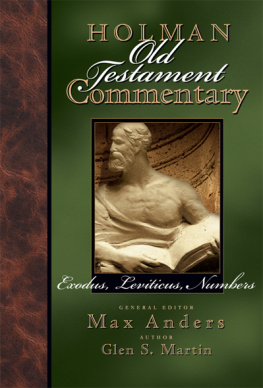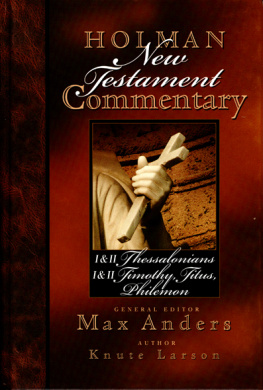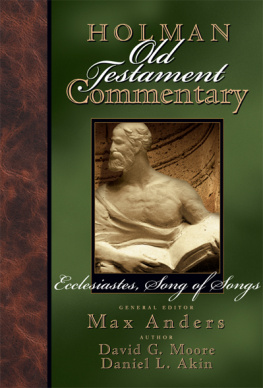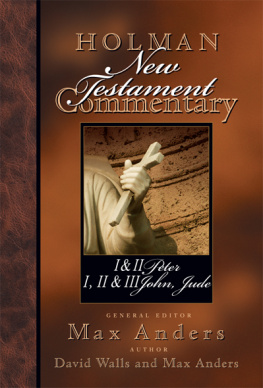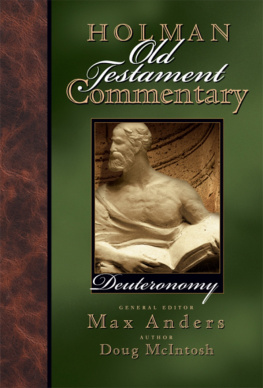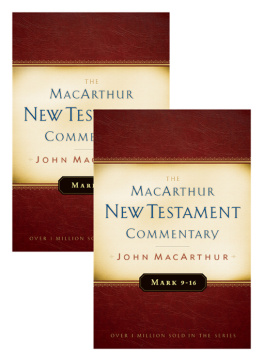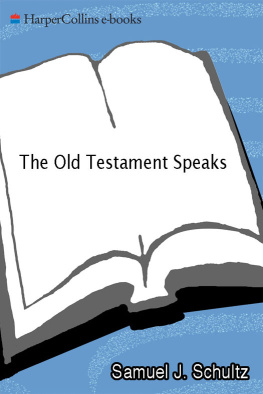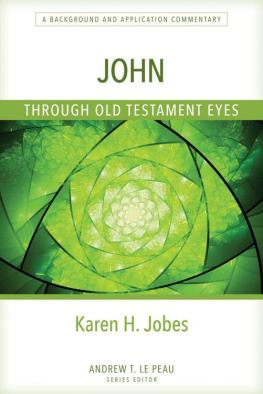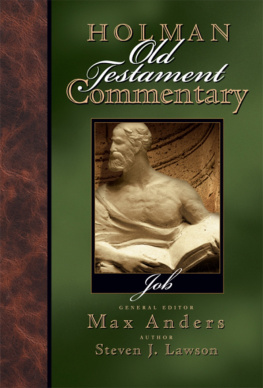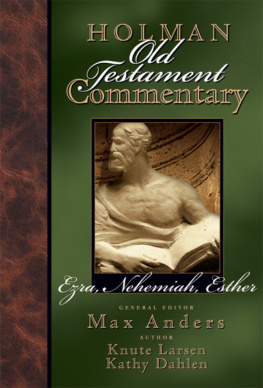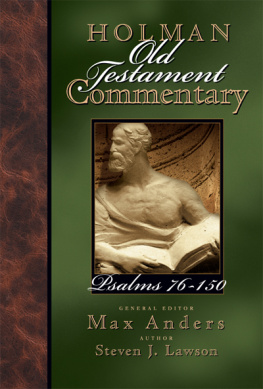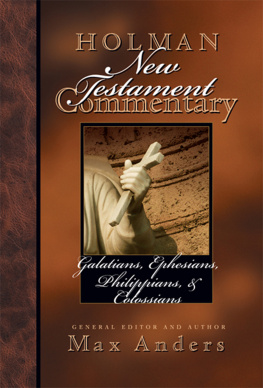
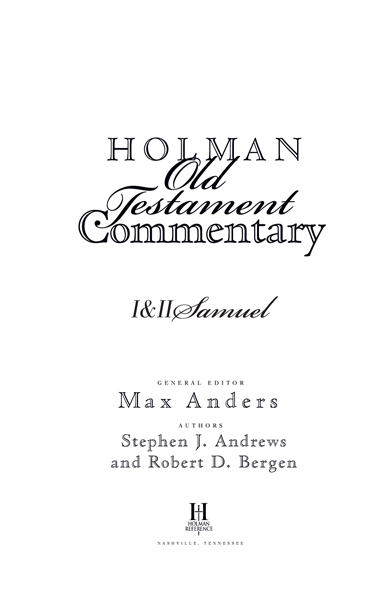

In memory of my father,
Rev. William Lee Andrews
(1927-2008),
who taught me
to love God's Word.
Stephen J. Andrews
To Martha and Wesley,
God's gifts of love,
inspiration,
and joy in my life.
Robert Bergen
Editorial Preface
Today's church hungers for Bible teaching, and Bible teachers hunger for resources to guide them in teaching God's Word. The Holman Old Testament Commentary provides the church with the food to feed the spiritually hungry in an easily digestible format. The result: new spiritual vitality that the church can readily use.
Bible teaching should result in new interest in the Scriptures, expanded Bible knowledge, discovery of specific scriptural principles, relevant applications, and exciting living. The unique format of the Holman Old Testament Commentary includes sections to achieve these results for every Old Testament book.
Opening quotations stimulate thinking and lead to an introductory illustration and discussion that draw individuals and study groups into the Word of God. In a Nutshell summarizes the content and teaching of the chapter. Verse-by-verse commentary answers the church's questions rather than raising issues scholars usually admit they cannot adequately solve. Bible principles and specific contemporary applications encourage students to move from Bible to contemporary times. A specific modern illustration then ties application vividly to present life. A brief prayer aids the student to commit his or her daily life to the principles and applications found in the Bible chapter being studied. For those still hungry for more, Deeper Discoveries takes the student into a more personal, deeper study of the words, phrases, and themes of God's Word. Finally, a teaching outline provides transitional statements and conclusions along with an outline to assist the teacher in group Bible studies.
It is the editors' prayer that this new resource for local church Bible teaching will enrich the ministry of group as well as individual Bible study, and that it will lead God's people truly to be people of the Book, living out what God calls us to be.
Holman Old Testament Commentary Contributors
Vol. 1 Genesis ISBN 978-0-8054-9461-7 Kenneth O. Gangel and Stephen Bramer Vol. 2 Exodus, Leviticus, Numbers ISBN 978-0-8054-9462-4 Glen Martin Vol. 3 Deuteronomy ISBN 978-0-8054-9463-1 Paul Douglas McIntosh Vol. 4 Joshua ISBN 978-0-8054-9464-8 Kenneth O. Gangel Vol. 5 Judges, Ruth ISBN 978-0-8054-9465-5 W. Gary Phillips Vol. 6 1 & 2 Samuel ISBN 978-0-8054-9466-2 Stephen Andrews and Robert D. Bergen Vol. 7 1 & 2 Kings ISBN 978-0-8054-9467-9 Gary Inrig Vol. 8 1 & 2 Chronicles ISBN 978-0-8054-9468-6 Winfried Corduan Vol. 9 Ezra, Nehemiah, Esther ISBN 978-0-8054-9469-3 Knute Larson and Kathy Dahlen Vol. 10 Job ISBN 978-0-8054-9470-9 Steven J. Lawson Vol. 11 Psalms 1-72 ISBN 978-0-8054-9471-6 Steven J. Lawson | Vol. 12 Psalms 73-150 ISBN 978-0-8054-9481-5 Steven J. Lawson Vol. 13 Proverbs ISBN 978-0-8054-9472-3 Max Anders Vol. 14 Ecclesiastes, Song of Songs ISBN 978-0-8054-9482-2 David George Moore and Daniel L. Akin Vol. 15 Isaiah ISBN 978-0-8054-9473-0 Trent C. Butler Vol. 16 Jeremiah, Lamentations ISBN 978-0-8054-9474-7 Fred C. Wood and Ross McLaren Vol. 17 Ezekiel ISBN 978-0-8054-9475-4 Mark F. Rooker Vol. 18 Daniel ISBN 978-0-8054-9476-1 Kenneth O. Gangel Vol. 19 Hosea, Joel, Amos, Obadiah, Jonah, Micah ISBN 978-0-8054-9477-8 Trent C. Butler Vol. 20 Nahum, Habakkuk, Zephaniah, Haggai, Zechariah, Malachi ISBN 978-0-8054-9478-5 Stephen R. Miller |
Holman New Testament Commentary Contributors
Vol. 1 Matthew ISBN 978-0-8054-0201-8 Stuart Weber Vol. 2 Mark ISBN 978-0-8054-0202-5 Rod Cooper Vol. 3 Luke ISBN 978-0-8054-0203-2 Trent C. Butler Vol. 4 John ISBN 978-0-8054-0204-9 Kenneth Gangel Vol. 5 Acts ISBN 978-0-8054-0205-6 Kenneth Gangel Vol. 6 Romans ISBN 978-0-8054-0206-3 Kenneth Boa | Vol. 7 1 &2 Corinthians ISBN 978-0-8054-0207-0 Richard Pratt Vol. 8 Galatians, Ephesians, Philippians, Colossians ISBN 978-0-8054-0208-7 Max Anders Vol. 9 1 &2 Thessalonians, 1 & 2 Timothy, Titus, Philemon ISBN 978-0-8054-0209-4 Knute Larson Vol. 10 Hebrews, James ISBN 978-0-8054-0211-7 Thomas Lea Vol. 11 1 &2 Peter, 1, 2, 3 John, Jude ISBN 978-0-8054-0210-0 David Walls & Max Anders Vol. 12 Revelation ISBN 978-0-8054-0212-4 Kendell Easley |
Holman Old Testament Commentary
Twenty volumes designed for Bible study and teaching to enrich the local church and God's people.
| Series Editor | Max Anders |
| Managing Editor | Steve Bond |
| Project Editor | Dean Richardson |
| Product Development Manager | Ricky D. King |
| Marketing Manager | Robin Patterson |
| Executive Editor | Tim Jordan |
| Page Composition | TF Designs, Greenbrier, TN |
Introduction to
__________________________________________________
1 and 2 Samuel
BACKGROUND
During the period of the judges, the Hebrew tribal groups had settled in their territories. Life revolved around the groups. Everyone shared in the land's resources. No central government imposed restrictions on the tribes or made demands on them. But, likewise, no king and his army stood ready to defend them. This shortcoming was particularly evident when the Philistines developed into a powerful force that threatened to drive the Israelites out of their homeland.
Finally, the elders of the tribes approached Samuel and asked him to appoint a king to become their new leader (1 Sam. 8:5). The difficult process of moving from an old, established form of government to a new organization headed by a king brought disappointment to Samuel (1 Sam. 8:6). He described for the people what the new form of government would cost them (1 Sam. 8:10-18). But they were determined to have a king to provide military protection, so God instructed Samuel to give them a king (1 Sam. 8:22). The books of 1 and 2 Samuel describe this transition to a kingship under Saul and the eventual emergence of David as the ruler over a united Israel and the establishment of David's dynasty.
COMPOSITION OF 1 AND 2 SAMUEL
Substantially the work of the prophet Samuel, 1 and 2 Samuel were written in the eleventh century B.C. However, their obvious connectedness with 1 and 2 Kings, as well as literary clues in the text (e.g., mention of the length of David's reign [2 Sam. 5:4], use of the phrase the kings of Judah [1 Sam. 27:6], indication that a term used as late as the eighth century B.C. was out-of-date at the time of writing [1 Sam. 9:9]), indicate that these books reached their final form during the Babylonian exile or shortly thereafter and were written using at least one other written source (the Book of Jashar; see 2 Sam. 1:18).
Next page

